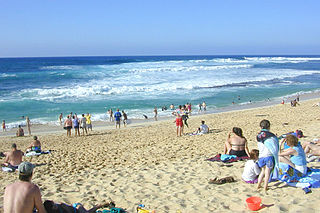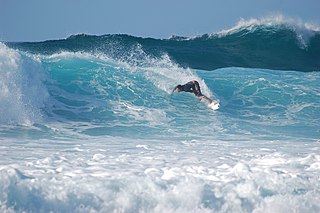Pūpūkea
Pūpūkea ( Hawaiian white mussel ) in Hawaiʻi is a town in the Koʻolauloa district on the north shore of the island of Oʻahu and belongs to Honolulu County . The Koʻolauloa district extends to Waimea Bay , and the Waialua district adjoins it in the south and west .
Pūpūkea is a popular place to live and vacation and is visited by numerous visitors and locals for surfing , especially in winter, and by divers and bathers in summer. The residential areas of Pukupea are located on a 100 to 200 meter narrow stretch of coast from Sunset Beach to Waimea Beach Park and in the hilly hinterland. Most of the bays and beaches are under nature protection.
This is where the Sunset Beach Fire Station is located , one of three fire stations on the North Shore. She is also responsible for sea rescue on the north coast.
The Kamehameha Highway runs along the coast . Right next to it, at the western entrance to the town, is the St. Peter and Paul Church, whose unusual church tower is one of the symbols of the North Shore. At this point there was a quarry in the early 1930s, in which rock was extracted for the construction of the highway from Waimea to Kahuku . In 1953 the Catholic Mission converted the tool shed into a church and the tall, rectangular storage silo for gravel of the disused facility into a church tower.
The entire hilly settlement area of Pupukea can only be reached via a pass-like road, the Pupukea Road. The highway and the streets in town have no sidewalks.
Although Pūpūkea is not a self-governing administrative unit , it is statistically recorded as a so-called census-designated place by the census authority. Pūpūkea is postal as a district of Haleʻiwa with the same zip code 96712. The city of Honolulu is approximately 70 km away.
geography
Pūpūkea is located on the Kamehameha Highway (State Road 83) west to southwest around Kawela Bay and northeast of Haleʻiwa . While the coastline is only a few meters above zero and in winter is washed over by high waves in some places, the hilly residential area rises from the cliffs at a height of 60 meters to 244 meters at the eastern end of Pupukea Road. The largest part is at an altitude of 122 to 183 meters.
The territory of the municipality covers an area of 15.8 km², which is divided into 8.8 km² of land and 7.0 km² of water. The high proportion of 44.17% water can only be explained by the fact that, unusually, part of the Pacific (probably Waimea Bay) was included.
meteorology
The water is never colder than 21 degrees, the wind blows constantly at around 6 Beaufort . In summer the water is clear and calm. However, the winter storms of the North Pacific cause waves up to 5 meters high, which can be predicted for a few days.
The average rainfall is 1389 mm on 247 days a year, many times higher than in Honolulu, where there is only 434 mm of rainfall on 89 days.
Demographics
In 2010 the place had 4551 inhabitants, 1580 households and 1011 families. The population density was 482.6 inhabitants / km². There were 1,878 housing units at a mean density of 191.9 per km²
The inhabitants stated their race in the census as follows: 59.5% "White", 0.6% "Black" or "African American", 0.4% "Native American", 12.0% Asians, 5.0% Hawaiians and Pacific Islanders, 2.2% "Other Races". 20.3% state two or more races. 8.8% of the population were race-independent Hispanics or Latinos.
In 2000, 32.8% of the households had children under the age of 18, 48% were spouses living together, 10.3% were run by women without a husband present, and 35.6% of the households did not belong to a family. 18.7% of all households were made up of individuals 3.4% were individuals living alone who were 65 years of age or older. The median household size was 2.92 and the median family size was 3.35.
23.6% were younger than 18, 10.1% between 18 and 24, 34.7% between 25 and 44, 24.3% between 45 and 64 and 7.3% 65 years or older. The median age distribution was 34 years. For every 100 women there are 114.6 men.
income
In 2016, the estimated median income per household was $ 101,146. Males had an estimated median income of $ 51,987 and females of $ 52,500. The estimated income per capita in 2019 is $ 42,157. 6.6% of the population lived below the poverty line . The unemployment rate is 2.1% in 2019.
Housing market
59.4% of the residents of Pupukea rent, 40.6% in their own house. The median price of a single family home in town is $ 1,000,700 in 2019 ($ 835,000 on O'ahu) and the median rent is $ 2,066 per month.
tourism
Surfing
As the motherland of surfing, Oahu and the other islands of Hawaii are home to the best beaches and surfing conditions worldwide. The main season for surfing is mainly the winter months.
Pūpūkea is home to some of the best surfing spots, such as the Banzai Pipeline, Sunset Beach and the first real “big wave spot” in Waimea Bay. The television series " Lost " was shot there. The beaches are only suitable for very experienced surfers. The world's most important surfing events take place here and in the immediate vicinity:
- Triple Crown of Surfing on Oahu's north coast in November
- Billabong Pipe Masters on the Banzai Pipeline in December
- Morey Bodyboards Worldchampionship on the north coast of Oahu in January
Diving / snorkeling

The great biodiversity in the protected marine areas makes the coast in front of Pūpūkea a popular diving area . Well-known diving and snorkeling spots are Three Tables and Sharks Cove in Pūpūkea Beach Park . Hawaii's official state fish, the Humuhumunukunukuāpua'a, is also found here .
Hiking / mountain biking
In the Pupukea-Paumalu forest reserve in the hills behind Sunset Beach, there is a labyrinth of well-marked trails for hiking and mountain biking in partly jungle-like surroundings with viewpoints on the cliffs of the various beaches. For mountain bikers there are jumps and ramps for every level of difficulty, which have also resulted in fatal accidents.
Cultural site
In the hills on the western edge of Pupukea near Waimea Beach Park at the Pu'u O Mahuka Heiau Historic Site is the largest ancient Hawaiian temple (Heiau) of O'ahu with an area of 8,000 m² (almost 2 acres). It was built in the 17th century and presumably served as a sacrificial temple where people were also sacrificed. It can be reached via a branch off Pupukea Road.
Sons and daughters of the place
- Don Morrow (born 1949), wrestler
Web links
- Information about the surf spots on Oahu
- State of Hawai'i - Division of Aquatic Resources
- Trails in the Pupukea-Paumalu forest reserve
Individual evidence
- ↑ Hawaiian Dictionaries wehewehe.org , accessed October 17, 2019
- ↑ Elevation Map.Retrieved July 17, 2017.
- ↑ Average Yearly Rainfall for Hawaii Current Results weather and science facts, accessed July 17, 2017.
- ↑ United States Census Bureau American Fact Finder, accessed July 15, 2017.
- ↑ American Fact Finder 2016 US Census Bureau, accessed December 22, 2017.
- ↑ Economy in Pupukea, Hawaii bestplaces.net , accessed August 8, 2019
- ↑ Pupukea, HI: What you need to know livability.com , accessed on August 8th, 2019
- ↑ Median price of single-family home on Oahu shatters old record hawaiinewsnow.com , August 6, 2019, accessed August 8, 2019
- ↑ Shark's Cove: North Shore's Popular Snorkeling Spot Exploration Hawaii, June 27, 2017, accessed July 16, 2017.
- ↑ Man dies after fall from Pupukea trail on mountain bike staradvertiser.com , August 14, 2019, accessed August 16, 2019
- ↑ Hawaii's Religions John F. Mulholland, 1989, accessed July 16, 2017.
- ↑ Puʻu O Mahuka Heiau State Historic Site Division of State Parks, accessed July 15, 2017.
Coordinates: 21 ° 40 ′ N , 158 ° 3 ′ W



